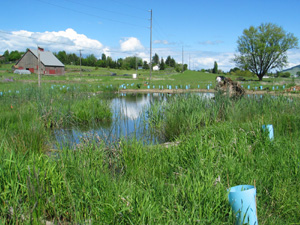 Watershed: Palouse River
Watershed: Palouse River
Stream Name: South Fork Palouse River
Date Established: 09/15/2003
Project Status: Project Complete; ongoing maintenance and monitoring
Overview
Funding Agency: Department of Environmental Quality (DEQ)
Project Location: Latitude: 46.7138 W, Longitude: 117.0151 N
Target Pollutants:
- Sediment
- Temperature
- Nutrients
- Bacteria
Waterbody Type(s): Intermittent
Hydrologic Unit Code: 17060108
Description
The restoration project was designed to mitigate local land use activities negatively influencing the water quality of the South Fork Palouse River (SFPR). The concrete berm on the south bank was constraining the stream channel causing in-stream erosion. Agricultural practices had resulted in a lack of vegetation and root structure along the stream bank leading to unstable and eroding banks. The lack of riparian buffer also did not protect the stream from detrimental effects of the overland runoff from the University of Idaho’s Arboretum. The Arboretum’s overflow was draining into the stream increasing sediment and nutrient loading. Also, the lack of riparian buffer lead to an increase in solar radiation causing an increase in stream temperaturesTo improve water quality of the SFPR site restoration strategies included:
- Reducing floodplain elevation and removing existing concrete berm to increase connectivity of channel to floodplain.
- Re-sloping and stabilizing stream banks.
- Constructing series of wetlands and stream side swales.
- Planting a variable width buffer of native trees, shrubs and grasses.
Previous Conditions
The SFPR is listed on the Idaho 1998 303(d) list as exceeding water quality standards for nutrients, temperature, bacteria and sediment. Other problems on the SFPR include reduced flow and habitat alteration.Past Beneficial Use Reconnaissance Program (BURP) studies, downstream monitoring and current water quality monitoring support the need for restoration on the SFPR (BURP 1996, BURP 1999, Hallock 1993, Myler 2002). The proposed Best Management Practices and restoration techniques will reduce sediment and nutrient loading to the SFPR, while stabilizing temperatures, improving habitat for wildlife and cold water biota and mitigating local flood damage.
Photo History
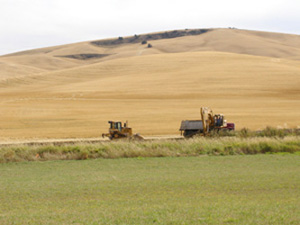 Excavation Begins (September 2003): In September 2003, excavation began to remove the berm along the top of the bank.
Excavation Begins (September 2003): In September 2003, excavation began to remove the berm along the top of the bank.
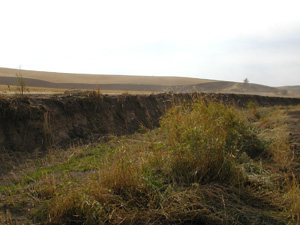 Berm Prior to Restoration Activities (September 2003)
Berm Prior to Restoration Activities (September 2003)
Berm prior to restoration activities September 2003-South stream banks after the reed canarygrass (Phalaris arundinacea) has been removed and before the initial berm removal.
Photo Point V1 Excavated Wetland (October 2003): A series of wetlands were created on the north side of the project to catch surface runoff and filter out sediments and nutrients from the University of Idaho Arboretum before being discharged into the South Fork Palouse River.
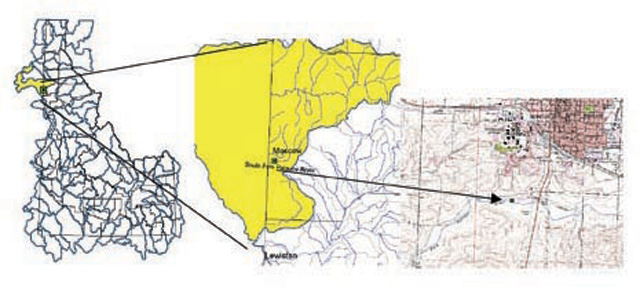 Map of Restoration Site: Map 1: South Fork Palouse River-Lower Watershed Restoration Project is located in the Palouse River Watershed in northern Idaho. The project is part of the City of Moscow Parks and Recreation facilities.
Map of Restoration Site: Map 1: South Fork Palouse River-Lower Watershed Restoration Project is located in the Palouse River Watershed in northern Idaho. The project is part of the City of Moscow Parks and Recreation facilities.
 After a High Water Event (February 2004): This photo shows the creek after high water due to snow melt and winter storms.
After a High Water Event (February 2004): This photo shows the creek after high water due to snow melt and winter storms.
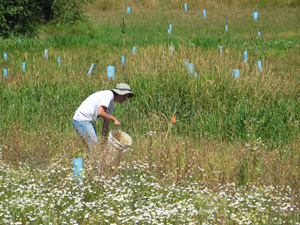 Watering the Plants (August 2004): Watering the Plants August 2004-A high school intern helps to water recently planted tree. It is important to water the plants during the first summer so that they experience less transplant shock, and have an easier time taking root in their new environment.
Watering the Plants (August 2004): Watering the Plants August 2004-A high school intern helps to water recently planted tree. It is important to water the plants during the first summer so that they experience less transplant shock, and have an easier time taking root in their new environment.
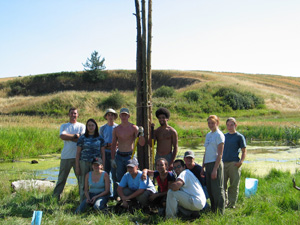 Habitat for Humanity Team Installs Perch Pole (August 2004): The team poses in front of a perch pole structure that contains habitat spaces for smaller birds. It is located at the north east end of wetland A.
Habitat for Humanity Team Installs Perch Pole (August 2004): The team poses in front of a perch pole structure that contains habitat spaces for smaller birds. It is located at the north east end of wetland A.
 Wetland A at Brimfull: Wetland A is at containment limit. When the wetland fills it seeps into the next wetland cell in the series. The series contains 4 wetland pools overall.
Wetland A at Brimfull: Wetland A is at containment limit. When the wetland fills it seeps into the next wetland cell in the series. The series contains 4 wetland pools overall.
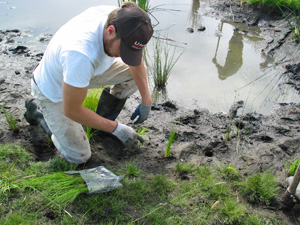 Planting Sedges and Rushes (July 2004): An intern from the University of Idaho plants many sedges and rushes in and around a wetland cell. These plants are often an indicator of a healthy wetland.
Planting Sedges and Rushes (July 2004): An intern from the University of Idaho plants many sedges and rushes in and around a wetland cell. These plants are often an indicator of a healthy wetland.
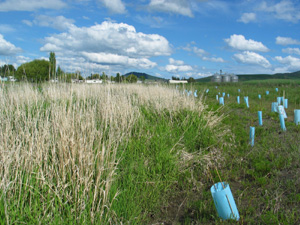 Bank Stabilization Photo Point S1 Upstream (May 2005): View of the bank and vegetation looking upstream.
Bank Stabilization Photo Point S1 Upstream (May 2005): View of the bank and vegetation looking upstream.
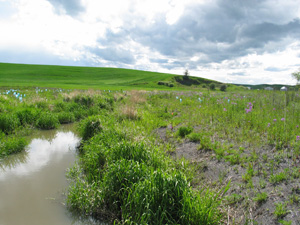 After Restoration Activities (March 2004): After Restoration Activities March 2004- the same stretch of stream after the banks have been re-sloped and stabilized.
After Restoration Activities (March 2004): After Restoration Activities March 2004- the same stretch of stream after the banks have been re-sloped and stabilized.
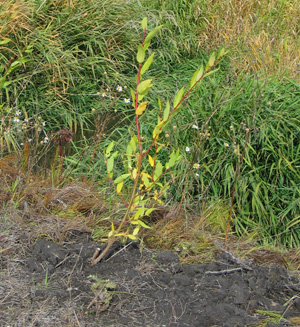 Newly Planted Mackenzie Willow (Salix mackenzieana)
Newly Planted Mackenzie Willow (Salix mackenzieana)
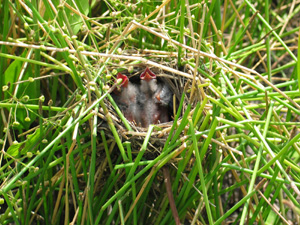 Red-winged Blackbird Nestlings: Young red-winged blackbirds (Agelaius phoeniceus) beg for their next meal in their nest built out of stream-side vegetation.
Red-winged Blackbird Nestlings: Young red-winged blackbirds (Agelaius phoeniceus) beg for their next meal in their nest built out of stream-side vegetation.
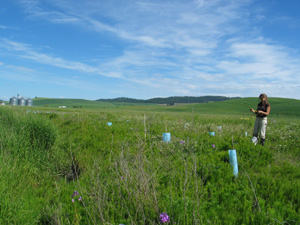 Monitoring and Data Collection After Restoration: PCEI staff, AmeriCorps members and volunteers monitor restoration effectiveness.
Monitoring and Data Collection After Restoration: PCEI staff, AmeriCorps members and volunteers monitor restoration effectiveness.
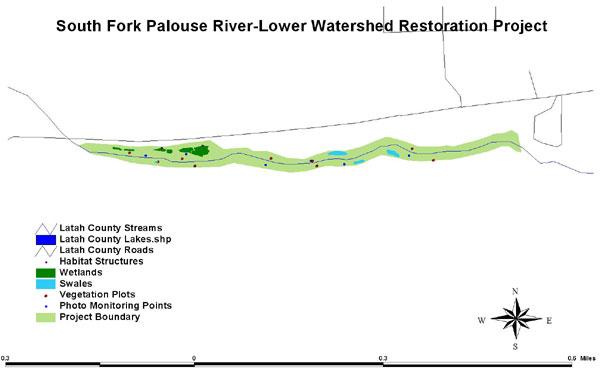 Site Map
Site Map
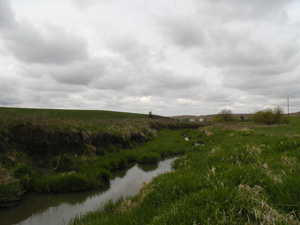 Before Restoration (April 2003): Erosion from steep banks along this 2800 foot section of the river are made worse by a concrete laden berm located at the top of the south bank.
Before Restoration (April 2003): Erosion from steep banks along this 2800 foot section of the river are made worse by a concrete laden berm located at the top of the south bank.
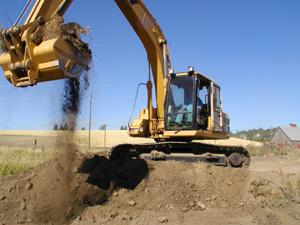 Berm Is Removed (September 2003): Excavator working hard to remove the berm.
Berm Is Removed (September 2003): Excavator working hard to remove the berm.
 Photo Point V1 (May 2005): Wetland was expanded and a large donated rootwad was placed in the wetland to provide additional habitat.
Photo Point V1 (May 2005): Wetland was expanded and a large donated rootwad was placed in the wetland to provide additional habitat.
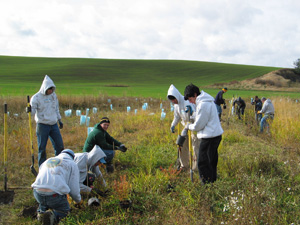 Volunteer Planting Event (October 2004): Volunteer Planting Event October 2004-Volunteers plant trees and woody plants on a brisk fall morning. Volunteer help with restoration projects is crucial in their success.
Volunteer Planting Event (October 2004): Volunteer Planting Event October 2004-Volunteers plant trees and woody plants on a brisk fall morning. Volunteer help with restoration projects is crucial in their success.
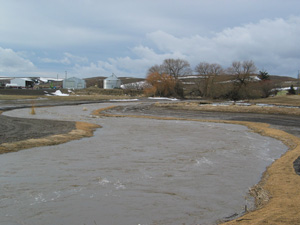 After Restoration During High Water (February 2004): High water during winter rains.
After Restoration During High Water (February 2004): High water during winter rains.
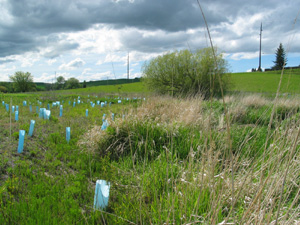 Bank Stabilization Photo Point S1 Downstream (May 2005): View of bank and vegetation looking downstream.
Bank Stabilization Photo Point S1 Downstream (May 2005): View of bank and vegetation looking downstream.
 Can you find them?: Killdeer (Charadrius vociferus ) nest located at the restoration project. Killdeer is one of many avian species utilizing the site.
Can you find them?: Killdeer (Charadrius vociferus ) nest located at the restoration project. Killdeer is one of many avian species utilizing the site.
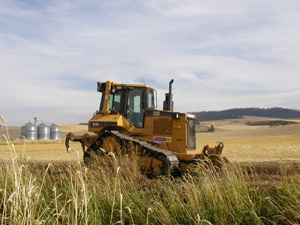 Wade and his bulldozer help knock down the berm (September 2003): In the first three days alone, over 300 dump-trucks of berm material were removed! Thanks to Wade, Bob, Don, Brian, and Bob!
Wade and his bulldozer help knock down the berm (September 2003): In the first three days alone, over 300 dump-trucks of berm material were removed! Thanks to Wade, Bob, Don, Brian, and Bob!
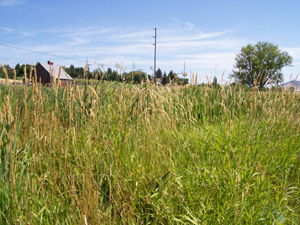 Photo Point V1 (August 2005): Wetland at high water levels due to watering at the University of Idaho Arboretum. Hard-stemmed bulrush (Scirpus acutus) and common cattails (Typha latifolia) dominate the foreground. The hard-stemmed bulrush was transplanted from a previous wetland restoration site.
Photo Point V1 (August 2005): Wetland at high water levels due to watering at the University of Idaho Arboretum. Hard-stemmed bulrush (Scirpus acutus) and common cattails (Typha latifolia) dominate the foreground. The hard-stemmed bulrush was transplanted from a previous wetland restoration site.
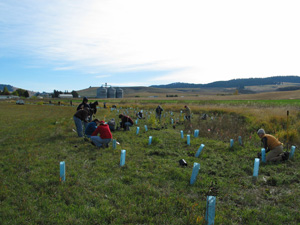 Volunteer Plant Protector Installation Event (October 2004): Volunteers from Washington State University Landscape Architecture class plant and place blue tubes. The blue tubes help to protect the plant from being gnawed on by rodents such as voles and rabbits. The tubes also help to mark the plant location so they do not get trampled, sprayed or mowed.
Volunteer Plant Protector Installation Event (October 2004): Volunteers from Washington State University Landscape Architecture class plant and place blue tubes. The blue tubes help to protect the plant from being gnawed on by rodents such as voles and rabbits. The tubes also help to mark the plant location so they do not get trampled, sprayed or mowed.
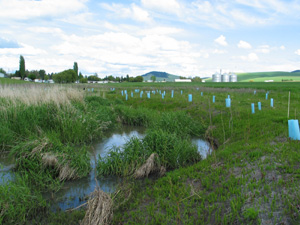 Bank Stabilization Photo Point S2 Upstream (May 2005): View of bank and vegetation.
Bank Stabilization Photo Point S2 Upstream (May 2005): View of bank and vegetation.
 Columbia spotted frog (Rana luteiventris) found in the new wetland. The spotted frog is considered an imperiled species by the Pacific Rivers Council. Photo by Javan Bauder.
Columbia spotted frog (Rana luteiventris) found in the new wetland. The spotted frog is considered an imperiled species by the Pacific Rivers Council. Photo by Javan Bauder.
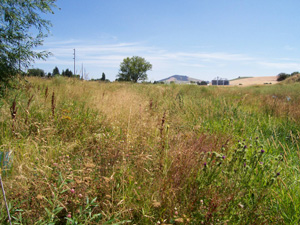 Photo Point V2 Upstream (August 2005): Photo of the riparian area looking upstream from the western end of the project.
Photo Point V2 Upstream (August 2005): Photo of the riparian area looking upstream from the western end of the project.
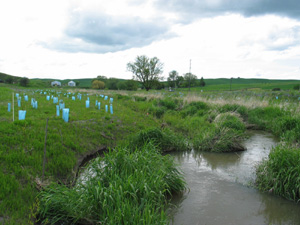 Bank Stabilization Photo Point S2 Downstream (May 2005): Channel is beginning to form a meander causing some bank undercutting.
Bank Stabilization Photo Point S2 Downstream (May 2005): Channel is beginning to form a meander causing some bank undercutting.
 Photo Point V3 Downstream (August 2005): View of the riparian looking downstream. Sweet clover (Melilotus officinalis) dominates this reach and native vegetation and blue tubes are almost completely hidden from view. Despite the overgrowth of sweet clover and red clover (Trifolium pratense), native plant survival success is approximately 96% for the first year following planting.
Photo Point V3 Downstream (August 2005): View of the riparian looking downstream. Sweet clover (Melilotus officinalis) dominates this reach and native vegetation and blue tubes are almost completely hidden from view. Despite the overgrowth of sweet clover and red clover (Trifolium pratense), native plant survival success is approximately 96% for the first year following planting.
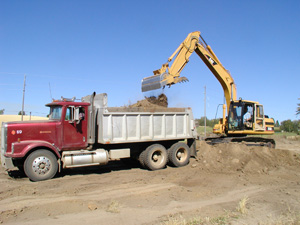 Bob Loads Up Brian’s Truck (September 2003): Another truckload full of soil from the berm gets hauled off site.
Bob Loads Up Brian’s Truck (September 2003): Another truckload full of soil from the berm gets hauled off site.
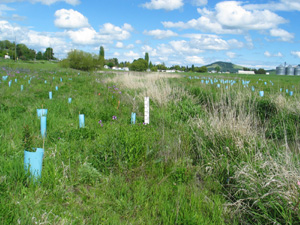 Photo Point V3 Upstream (May 2005): View of the developing riparian at photo point 3 looking upstream at approximately the middle of the project. A meter stick is used to create a visual reference point.
Photo Point V3 Upstream (May 2005): View of the developing riparian at photo point 3 looking upstream at approximately the middle of the project. A meter stick is used to create a visual reference point.
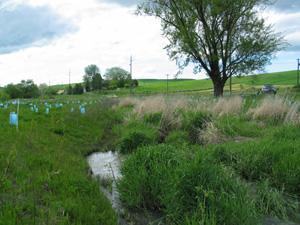 Bank Stabilization Photo Point S3 Downstream (May 2005): View of the bank and vegetation looking downstream. Channel is beginning to cut a meander causing some bank instability.
Bank Stabilization Photo Point S3 Downstream (May 2005): View of the bank and vegetation looking downstream. Channel is beginning to cut a meander causing some bank instability.
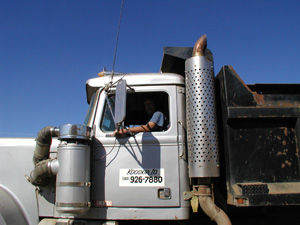 Brian in the Truck (9/17/2003): Brian is happy to take off another load.
Brian in the Truck (9/17/2003): Brian is happy to take off another load.
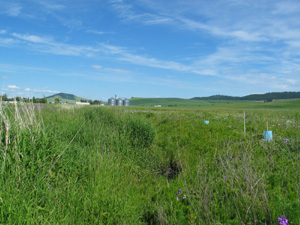 Bank Stabilization Photo Point S3 Upstream (May 2005): View of the bank and vegetation looking looking upstream.
Bank Stabilization Photo Point S3 Upstream (May 2005): View of the bank and vegetation looking looking upstream.
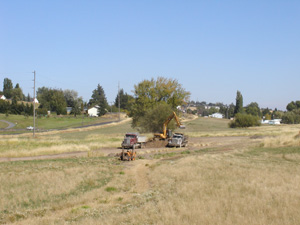 Last pile of berm (9/22/2003): Over 600 loads have left the site. Here is the last pile.
Last pile of berm (9/22/2003): Over 600 loads have left the site. Here is the last pile.
 Photo Point V3 Downstream (May 2005): View of the riparian looking downstream. Blue tubes are used to protect plants from browsing from rodents and to provide a visual marker. Plant protectors also provide a microhabitat for the young plant.
Photo Point V3 Downstream (May 2005): View of the riparian looking downstream. Blue tubes are used to protect plants from browsing from rodents and to provide a visual marker. Plant protectors also provide a microhabitat for the young plant.
 Site excavation continues (September 2003): Wade wraps up the day, ready to start sloping the bank in the morning, 9/22/03.
Site excavation continues (September 2003): Wade wraps up the day, ready to start sloping the bank in the morning, 9/22/03.
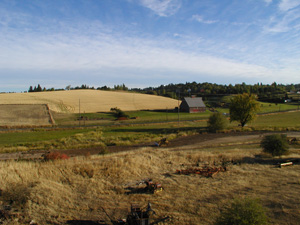 Berm removed! (9/22/2003): Shown is a view looking north across the project. The dark band of soil in the middle of the project next to the stream is the location of the former berm.
Berm removed! (9/22/2003): Shown is a view looking north across the project. The dark band of soil in the middle of the project next to the stream is the location of the former berm.
 South Fork Palouse River During High Flow (May 2005): South Fork Palouse River at the restoration site during high flow.
South Fork Palouse River During High Flow (May 2005): South Fork Palouse River at the restoration site during high flow.
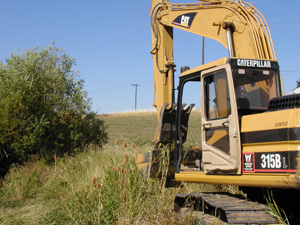 Bob Removes Clumps of Non-native Reed Canary Grass From the Banks (9/24/2003): After removing the berm, the next step is to remove the non-native reed canary grass to reduce this invasive species and to enable the workers to see the banks that need to be sloped back.
Bob Removes Clumps of Non-native Reed Canary Grass From the Banks (9/24/2003): After removing the berm, the next step is to remove the non-native reed canary grass to reduce this invasive species and to enable the workers to see the banks that need to be sloped back.
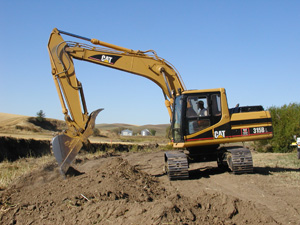 Pulling Banks: Bob is pulling back the banks on Friday, September 26th to a 3:1 slope. So far, more than 1,000 dump truck loads of soil have been removed from the river banks.
Pulling Banks: Bob is pulling back the banks on Friday, September 26th to a 3:1 slope. So far, more than 1,000 dump truck loads of soil have been removed from the river banks.
 Look at That Concentration!: Wade is pushing soil toward the excavator to be loaded into the trucks.
Look at That Concentration!: Wade is pushing soil toward the excavator to be loaded into the trucks.
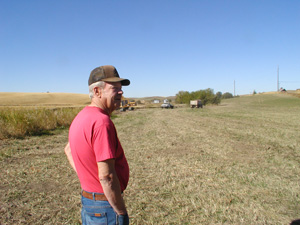 Out of the Cab for a Stretch: Bob is catching a moment between loads to stretch out a bit.
Out of the Cab for a Stretch: Bob is catching a moment between loads to stretch out a bit.
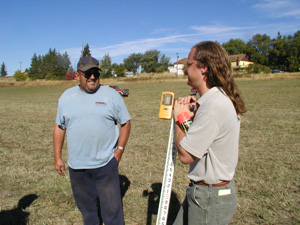 Consulting with the Engineer: Don (left) consults with Erik Ryan from TerraGraphics (right), between truckloads.
Consulting with the Engineer: Don (left) consults with Erik Ryan from TerraGraphics (right), between truckloads.
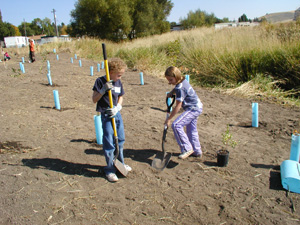 Planting Has Begun! Annual Watershed Festival September 2003: On September 30, nearly 200 4th grade children descended upon the project site to participate in the Third annual watershed festival. The children planted 400 trees and shrubs along the first 600 feet of the NE end of the project.
Planting Has Begun! Annual Watershed Festival September 2003: On September 30, nearly 200 4th grade children descended upon the project site to participate in the Third annual watershed festival. The children planted 400 trees and shrubs along the first 600 feet of the NE end of the project.
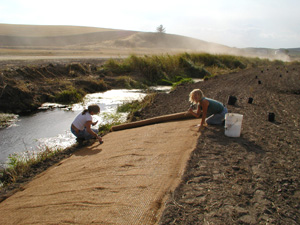 Tracy and Sara Staple Down Erosion Control Fabric on the North Side of the River: More than 600 dump truck loads of soil were removed from the North bank. Now trees are being planted, native grass is being seeded and fabric is being installed.
Tracy and Sara Staple Down Erosion Control Fabric on the North Side of the River: More than 600 dump truck loads of soil were removed from the North bank. Now trees are being planted, native grass is being seeded and fabric is being installed.
 Ken Pins Down Fabric (10/9/2003): Ken lays out fabric with new trees immediately behind him on the north bank. Excavation work has now shifted to the South Bank of the River.
Ken Pins Down Fabric (10/9/2003): Ken lays out fabric with new trees immediately behind him on the north bank. Excavation work has now shifted to the South Bank of the River.